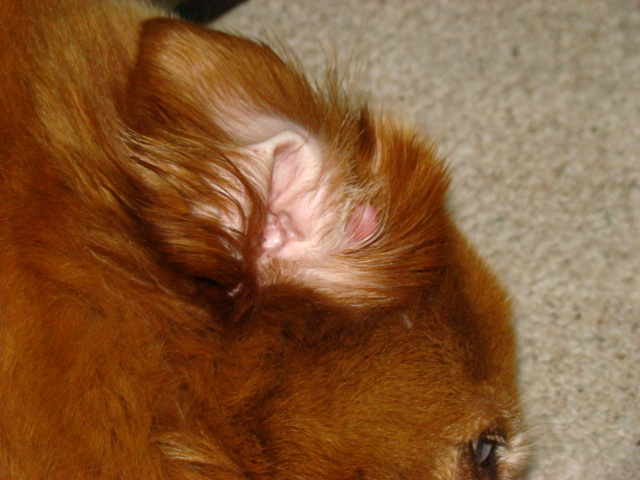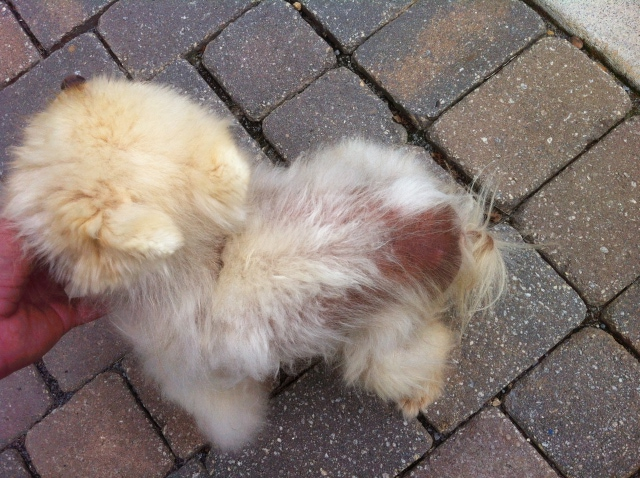QuestionI have an 8 yr old Peke, when she was a puppy we fed her pedigree puppy then I switched to regular pedigree (my vet said there was too much ash content in the puppy food) she would not eat the adult food, she went 8 days without touching food, (I starting trying all different kinds from canned to dry...and nothing) So I started feeding her "People Food" chicken w/carrot& rice, beef w/rice etc. Recently she has started scratching and her skin got scabby, her fur is not growing back like it used to, and her belly is starting to turn black, I thought it was dirt. I took her to the vet and he seems to think she is allergic and has given her cortisone shots and antibiotics twice. The vet also said to try lamb. She ate the lamb w/rice & carrot for a few days and now won't touch it. I am trying to stay off the chicken thinking that is what she is allergic too. She had stopped scratching and her skin cleared up for about two weeks. She is now starting to scratch again and I don't want her to have anymore cortisone shots, someone told me it affects their heart. She is a very picky eater (she finds smelly food offensive and walks away) She will eat cheese (any kind) and her milk bone biscuits. Her stratching is driving us crazy along with not eating please suggest something. I am getting very concerned.
AnswerHi Karen,
To see if the diet the problem here, you can try a food trial. This is a controlled method of ruling out possible allergens by feeding a food that contains a protein and carbohydrate source which the dog has never been exposed to. You'd need to stick to the food trial diet for a period of up to 8-10 weeks (or longer) and monitor your dog's response. Symptoms should lessen if your dog is indeed food-allergic. To carry out a valid food trial, you'll have to either buy a therapeutic diet from your veterinarian, or buy one of the "over the counter" hypoallergenic dogs foods made with "novel" protein and carb sources. This means your dog needs to be fed a diet she's never received before, containing ingredients she's never encountered. Just switching to a Lamb based diet is not the same as using a hypoallergenic diet. That's why the diets I've listed below are based on sort of odd, but totally nutritious, meat sources. There are several really good over the counter hypoallergenic dog foods these days that you can use for a food trial. Brands to look for are:
Wellness Simple Solutions Rice and Salmon
http://www.wellnesspetfood.com/dog_wellness_simple_food_solutions_salmon.html
Wellness Simple Solutions Rice and Duck Formula
http://www.wellnesspetfood.com/dog_wellness_simple_food_solutions_duck.html
Canidae Grain Free Salmon
http://www.canidae.com/dogs/grain-free-salmon/dry.html
Fromm Four-Star Nutritionals Whitefish & Potato
http://www.frommfamily.com/products-fs-d-d-whitefish.php
California Natural Herring & Sweet Potato
http://www.californianaturalpet.com/products/default.asp?id=1326
To get conclusive results from the trial, your dog should ingest nothing but the elimination diet and water. That means no treats, rawhide, or chewable medications. If your dogs feet are no longer itching 8-10 weeks after starting the food trial, you can assume something in your dog's diet was causing the allergy.
Cortisone, and all of the corticosteroid medications, do have some health concerns associated with long term use. It's a powerful drug, but it's useful in stopping severe itching. You shouldn't abruptly stop using Cortisone, it needs to be tapered off, over a period of a few days so that your dog's body has time to reestablish natural cortisol production. You need to use the lowest possible dose that gives you the results you want, so you may want to talk to your vet about that. It's possible to use this medication for when itching is at it's worst, and then taper off of it, rather than keeping your dog on it all of the time. Topical ointments containing corticosteroid are effective and usually offer the lowest risk for adverse reactions. However, if your dog is able to reach the area and licks the medication, the dog is likely to ingest too much of the corticosteroid. If your dog's itchy areas aren't a spot she can lick, this might be a good option.
What's best it's best to find the cause of the itch, such as by doing a food trial, and not to need to use the cortisone at all. You need to weigh the torture of severe itching (and the secondary skin infections that can go along with that) to the relief a medication (and it's risks). All medications, even aspirin have risks. With proper dosage and careful monitoring, corticosteroids can significantly lessen your dog's symptoms while you work to find the cause of the problem.
If after the food trial, your dog seems just as itchy, then you need to look at other allergens such as pollen or mold, materials such as wool, laundry detergent or house hold chemicals or cleaners that might be the problem. In difficult cases, it can be helpful to have a veterinary dermatologist examine your dog. If your regular vet can't give you a referral, you can locate one here:
https://www.acvd.org
I hope I've been a help.
Best of luck,
Patti

 7 week old lurcher pup
Question
this is Lady
hi there me and my partner purch
7 week old lurcher pup
Question
this is Lady
hi there me and my partner purch
 Ear Care
Question
Erins Ear 2
I had my dog groomed two days ago
Ear Care
Question
Erins Ear 2
I had my dog groomed two days ago
 Hair growth stimulation
Question
Hairless Pom
A few years back I cut my
Hair growth stimulation
Question
Hairless Pom
A few years back I cut my
 why now?
Question
my dog
I have a 2 year old dog, that mo
why now?
Question
my dog
I have a 2 year old dog, that mo
 Pomeranian or Pomeranian mix
Question
Brandy my Pomeranian
Hi I have a Dog na
Pomeranian or Pomeranian mix
Question
Brandy my Pomeranian
Hi I have a Dog na